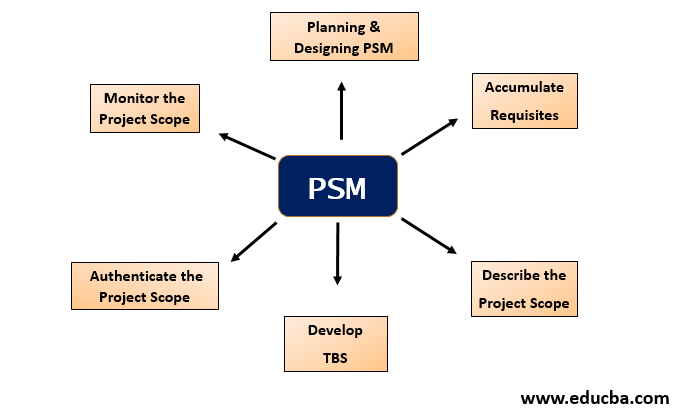
Introduction to Project Scope Management
Project Scope Management (PSM) is vital in defining the success or failure of a project so as to deliver products/services of high quality. PSM can be defined as “A methodology that includes the list of detailed work/tasks to be executed to attain project objectives”. PSM is a set of assigned functionalities, allowing us to define and monitor the scope of a project precisely and efficiently. PSM enables the project supervisors to manage time and resources adequately by distributing the right number of tasks required to run a project. As PSM identifies and evaluates tasks, inclusive and exclusive to the project scope, it helps to avoid irrelevant tasks by saving on time to achieve maximum returns.
Stages of Project Scope Management
Irrespective of the methods chosen, the project administrator has to define the project scope and evaluate the same.
Therefore, PSM consists of the following steps:
1. Outlining the Project Requirements
The initial stage is identifying the project goals so as to determine the project schedule and assign the resources. Only as these factors are identified, the tasks to be done to complete the project can be enlisted. Thus, the ‘project scope’ is outlined, based on which the project team is allocated task roles limited to a specific budget and time.
2. Identifying Project Goals
The next stage requires determining project objectives, which is the nucleus of a project. There could be more than one objective to a project, and the project administrator, along with the team, is required to meet those so as to deliver products/services of superior quality.
3. Determining the Project Scope
Project Scope consists of resources and tasks allotted to deliver a particular product or service. Thus, the project scope is a reflection of the project goals that aim to deliver high-end results.
Six Practices of Project Scope Management (PSM)
The six practices of PSM are:
As per ‘GPMBK (Guide to the Project Management Body of Knowledge)’, PSM is fundamentally about determining and monitoring tasks that are to be included or excluded from a project.
GPMBK lists 6 practices of PSM to be implemented to manage and monitor a project:
1. Planning and Designing PSM
The first practice of PSM involves planning and developing of Scope Management Plan (SMP). SMP is prepared to consult with the project stakeholders and retrieve information from the project plan and the charter. Thus, SMP enables one to determine, manage, monitor and evaluate the scope of a project.
2. Accumulate Requisites
The second practice is to determine the requisites of the project stakeholders and document the same. This process employs various tools and methods (such as Interviews, Survey Questionnaires, Focus group discussions, Observation methods) to extract information about the stakeholder’s requirements and expectations from a project. This enables the project administrators to prevent the chances of possible errors or obstacles during the course of a project.
3. Describe the Project Scope
In this method, the project scope is determined to explain a project’s outcomes and what it cannot deliver or is out of the scope. The scope that is generated outlines the stakeholder expectations from a project, which is conveyed to the project team. Finally, the documented records are evaluated to ensure that the project deliverables are in sync with the project goals.
4. Develop a Task Breakdown Structure (TBS)
One of the vital practices of PSM enables the project supervisors and the team to break down comprehensive scope statements into smaller and feasible units of work. These fractionated pieces of work are termed as ‘work packages’. Thus, TBS is a collection of these work units that are required to complete the entire project. Therefore, it enables the project team to work efficiently and with pace.
5. Authenticate the Project Scope
At this stage, the project deliverables are reviewed by internal and external stakeholders for authentication. Basically, it is a stage that focuses primarily on stakeholder acceptance of project deliverables. The project stakeholders give feedback and pass approval for the same if the end results meet the expected standards and requisites.
6. Monitor the Project Scope
It has been rightly said that, rather than a well-defined project scope, it should be well-monitored. This stage compares the project requisites against the performance review reports to identify the gaps or lacunae in a project, which might require the SMP to be modified. Therefore, it is paramount to keep track of the progress of the project to be assured of its execution as per the SMP, as the SMP might require any alterations or changes if the stakeholders come up with new requisites.
Conclusion
To conclude, it cannot be denied that a well-structured PSM is vital to a project’s success. It is worth an investment in spite of the time and efforts put into the implementation of its practices as it enables to yield maximum returns over minimum overruns. PSM training is definitely beneficial, as it provides the knowledge and expertise about scope management, which is one of the core functionalities in managing projects. PSM training is a good career option for prospective learners who wish to establish their niche in the field of project management.
The training course would also be an added advantage to the project supervisors/managers who face challenges in completing the projects, either on time or within the allotted budget. Upon completion of the course, doors are open to several career opportunities in the domain of project management across public and private organizations.
Recommended Articles
This is a guide to Project Scope Management. Here we discuss the introduction and stages of PSM along with six practices of Project Scope Management. You can also go through our other suggested articles to learn more–


